Synthesis, characterization, and design of molecular materials, especially molecular conductors (including superconductors ), have been undertaken. Molecular conductors exhibit a variety of physical properties which can be systematically understood on the basis of "simple" and "clear" electronic structures. From a chemical point of view, the most fascinating character of the molecular conductor is its "designability", that is, we can finely control solid state properties with chemical modifications of the molecule. The newly synthesized materials are characterized by the X-ray diffraction method and physical measurements (electrical conductivity...etc.). The electronic structure is investigated by the simple band structure calculation. All these results are devoted to the design of new molecular materials.
-
1. Development of molecular conductors based on novel metal dithiolene complexes
(1)Structure and physical properties of a molecular conductor Me4N[Pd(dmit)2]2 under high pressure
(2)Structure and physical properties of a molecular conductor Me3ViN[Ni(dmit)2]2
(3)Development of molecular conductors based on bimetallic dithiolene complexes including a bridging
tetrathiooxalate (tto) ligand with orbital degrees of freedom
(4)Development of molecular conductors based on donor type Ni-dddt complexes with cycloalkane
2.Physical properties of molecular conductors on silicon substrate and their field effects
3.Massless Dirac Fermions in Organic Conductors
(1)Inter-layer magnetoresistance
(2)Dielectric property
-
1. Development of molecular conductors based on novel metal dithiolene complexes
(1)Structure and physical properties of a molecular conductor Me4N[Pd(dmit)2]2 under high pressure
A.Tajima, Fukunaga, Kato
Metal dithiolene complexes have provided a variety of molecular conductors. Among them, most of Pd(dmit)2 salts belong to a strongly correlated two-dimensional system with a quasi triangular lattice of [Pd(dmit)2]2- dimers. Their electronic state is associated with various degrees of freedom (including charge, spin, orbital, and lattice) and can be modified by pressure. Me4N salt was reported in the early stage of the research on the Pd(dmit)2salts. Two forms,α(triclinic, P 1) andβ(monoclinic, C2/c), were known. We have found the third form, the γform (monoclinic, Cc). Although these three forms share common structural properties, anisotropies of inter-dimer interactions within the conduction layer are different from each other. At ambient pressure, they are all Mott insulators. Temperature dependent resistivity of the a form shows an anomaly at ca.110 K and a peak around 20 K with sample dependence, which is different from the previous report. Surprisingly, the application of hydrostatic pressure to the γform induces an irreversible structural change toward the αform. In addition, rapid application of pressure induces superconductivity (Tc = 4 K at 3 kbar). Since the a form under the uni-axial strain along the a+b direction is found to exhibit superconductivity with Tc = 7 K at 3 kbar, it is plausible that this superconductivity originates from the a form domain in non-hydrostatic environment.
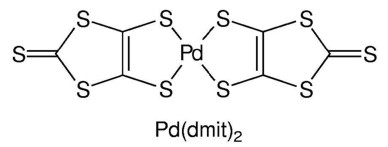
↑Top
(2)Structure and physical properties of a molecular conductor Me3ViN[Ni(dmit)2]2 Darpin, Fukunaga, Kato
We prepared new Ni(dmit)2 anion radical salts with Me3ViN+ cation, and carried out X-ray crystal structure analysis at room temperature and 150 K. The salt is a semiconductor, and shows structural transition around 240 K which is associated with resistivity anomaly. At room temperature, the cation looks like a Me4N+ cation, because the position of a terminal C atom of the vinyl group is disordered. At 150 K, the cation moiety is ordered. The space group changes from Pccn to Pna21where the inversion centre disappears in the crystal. In the low temperature crystal structure, all the vinyl groups turn in the same direction.

↑Top
(3)Development of molecular conductors based on bimetallic dithiolene complexes including a bridging tetrathiooxalate (tto) ligand with orbital degrees of freedom Kubo, Fukunaga, H.M Yamamoto, Kato
Previously, we succeeded in preparation and crystallization of bimetallic complexes with tto bridging ligands [(tto)Ni2(S-S)2]2-; S-S = dmit, dmise, tdas, dddt, edo; dmit = 1,3-dithiole-2-thion-4,5-dithiolete; dmise = 1,3-dithiole-2-selenon-4,5-dithiolete; tdas = 1,2,5-thiadiazole-3,4-dithilate; dddt = 5,6-dihydro-1,4-dithiine-2,3-ditholate; edo = 5,6-dihydro-1,4-dioxine-2,3-dithiolate; Figure).
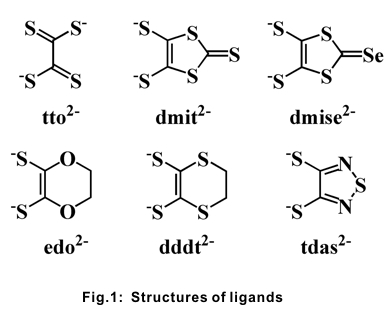
Spectroscopic measurements and MO calculations of the complexes were performed. UV-VIS-NIR spectra can reveal energy gaps between molecular orbitals around HOMO and LUMO. The spectra were analyzed based on their X-ray molecular structural data by using of RIKEN RSCC system. These analyses suggest that the bimetallic complexes have very small HOMO-LUMO gap which would induce orbital degrees of freedom around the conduction band. Highly symmetrical molecular orbitals were also observed in their HOMO orbitals (Figure). Thus, the complexes are good candidates for single component molecular metal, new type of molecular conductors with highly external-stimuli responses and multiferroics.
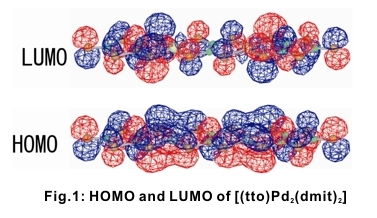
↑Top
(4)Development of molecular conductors based on donor type Ni-dddt complexes with cycloalkane Kubo, Fukunaga, H.M Yamamoto, Kato
The acceptor type metal bis-dithiolene complexes including [M(dmit)2] (M = Ni, Pt and Pt) have been extensively studied, and are known to provide various anion radical salts which exhibit superconducting and metallic behavior. The donor-type metal bis-dithiolene complexes are also promising materials for molecular conductors. However, the number of metals based on the donor type metal bis-dithiolene complexes is quite limited. Previously, we reported preparation and physical properties of donor type molecules based on Ni-dddt complexes with cyclopentane, cyclohexane, cycloheptane and cyclooctane, [Ni(Cn-dddt)2] (n = 3, 4, 5, 6). In this work, single crystals of cation radical salts (anion=PF6- , ClO4- ) of the complexes with the cyclopentane moiety were obtained. The crystals have unique molecular arrangements due to the bulky cyclopentane substituents (Figure).
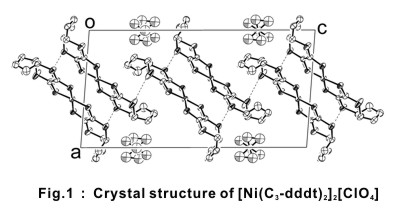
Both of the crystals have similar structures. Quasi-one dimensional intermolecular interactions and Fermi surfaces were indicated by tight-binding band calculations based on their crystal structures. The salts, however, are semiconductors due to the strong electron correlation. Magnetic susceptibility measurements revealed that the salts are paramagnetic insulators.
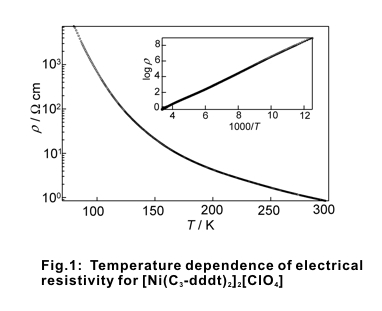
↑Top
2.Physical properties of molecular conductors on silicon substrate and their field effectsH.M Yamamoto, Kawasugi, Ueno, Tajima, Fukunaga, Kato
Conduction properties of molecular conductors have been controlled by the field effect. κ-(BEDT-TTF)2Cu[N(CN)2]Br exhibits superconductivity at 10 K in its bulk phase. It, however, turned to a Mott-insulator at low temperature when its thin-layer single-crystal was laminated onto a SiO2/Si substrate due to the negative pressure effect from the substrate. This device based on the Mott-insulating state showed an n-type transistor behavior. Its device mobility reached 94 cm2/Vs, which is the highest among organic field effect transistors. Meanwhile, the activation energies of this device could be reduced from 25 meV to 1 meV by applying the gate voltage. This behavior is quite similar to that of the Si-MOSFET inversion layer. The analysis based on Hall coefficient measurements is now under way. Device fabrication and transport measurements with (BETS)2GaCl4 on PDMS/Al substrate were also examined. (BEDT-TTF = bis(ethylenedithio)tetrathiafulvalene, MOSFET = Metal-Oxide-Semiconductor Field Effect Transistor, BETS = bis(ethylenedithio)tetraselenafulvalene, PDMS = Polydimethylsiloxane)

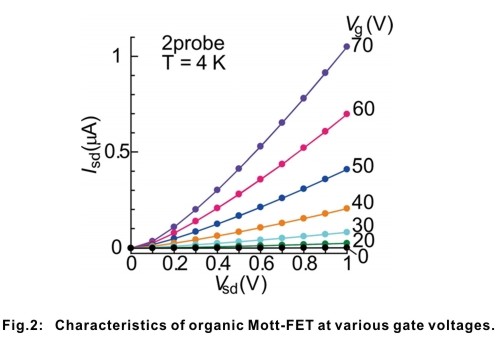
↑Top
3.Massless Dirac Fermions in Organic Conductors)N. Tajima, Ahmad, Kato
In this work, we investigated (1) inter-layer magnetoresistance and (2) dielectric property of massless Dirac Fermions system α-(BEDT-TTF)2I3. The purpose is to clarify the nature of Dirac particles in this system.
(1) Inter-layer magnetoresistance
We have investigated inter-layer magnetoresistance in an organic massless Dirac Fermions system, α-(BEDT-TTF)2I3, under hydrostatic pressure. This material exhibits the first two-dimensional zero-gap state in a bulk crystal with a layered structure. In the zero-gap system, n=0 Landau level (zero-mode) always appears at the contact points of Dirac cones under the magnetic field normal to the two-dimensional plane. We demonstrated that the increase of zero-mode degeneracy conduces strong negative inter-layer magnetoresistance. This is a characteristic feature of transport in multilayer massless Dirac Fermions systems. At high magnetic field, spin splitting of the zero-mode level plays an important role in determining the carrier density. It works to reduce the density. Inter-layer resistance depends on the magnetic field (B) and the temperature (T) as exp(μBB/kBT).

↑Top
(2) Dielectric propertyIn this work, the low frequency dielectric spectroscopy measurements have been performed along the different crystallographic directions of organic conductor α -(BEDT-TTF)2I3. The charge order phase transition at 135 K manifests itself by a sharp drop of the ac conductivity by several orders of magnitude. In the high temperature phase, the dielectric constant in the conduction plane exhibits a giant value of about 106, which is almost independent of temperature and frequency. This unusual giant dielectric behavior may be intrinsic in nature, due to the charge disproportionation that already exists in the room temperature phase. At the charge order transition, the dielectric constant abruptly decreases to still a high value of 7000 - 10000.
↑Top












